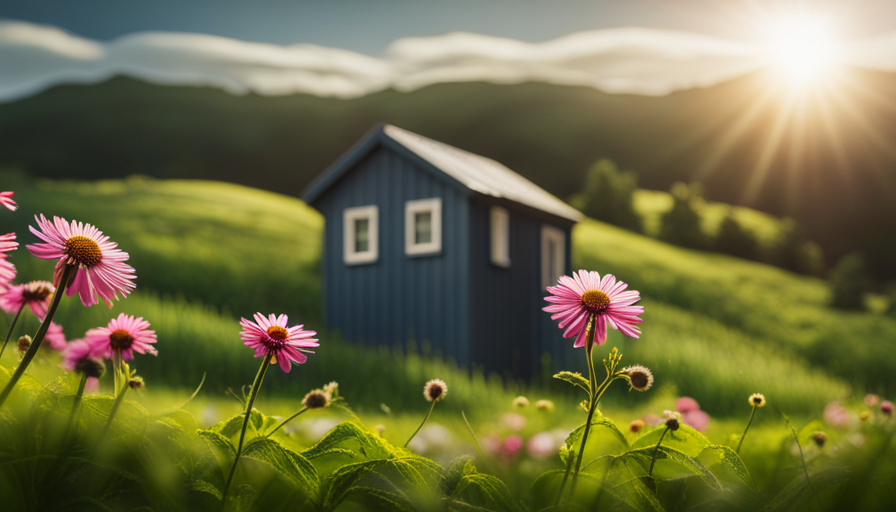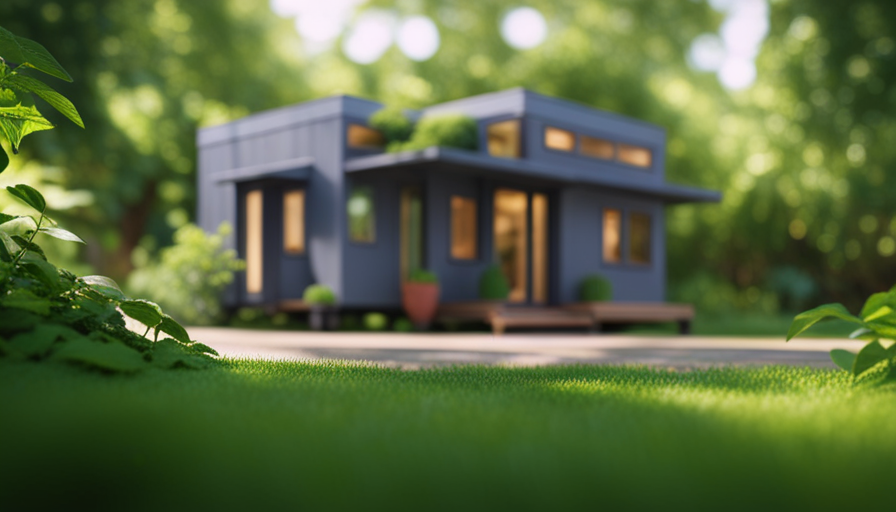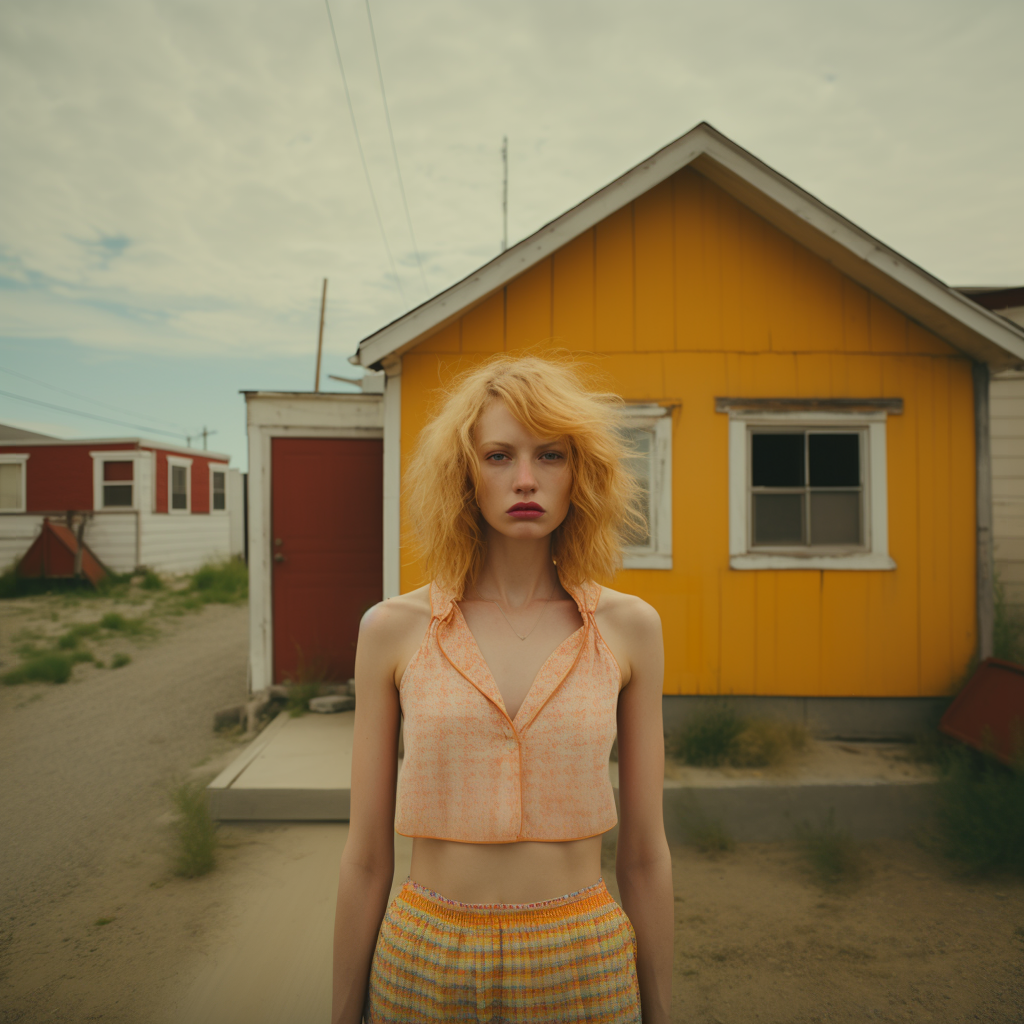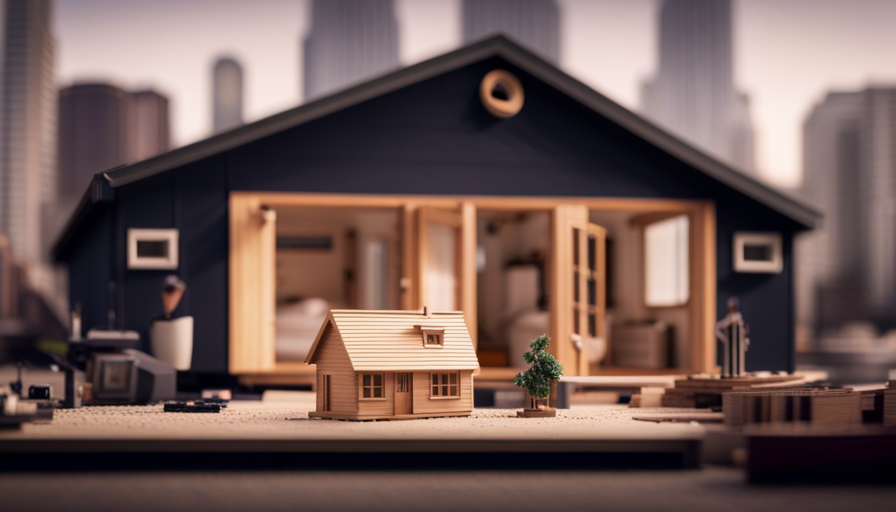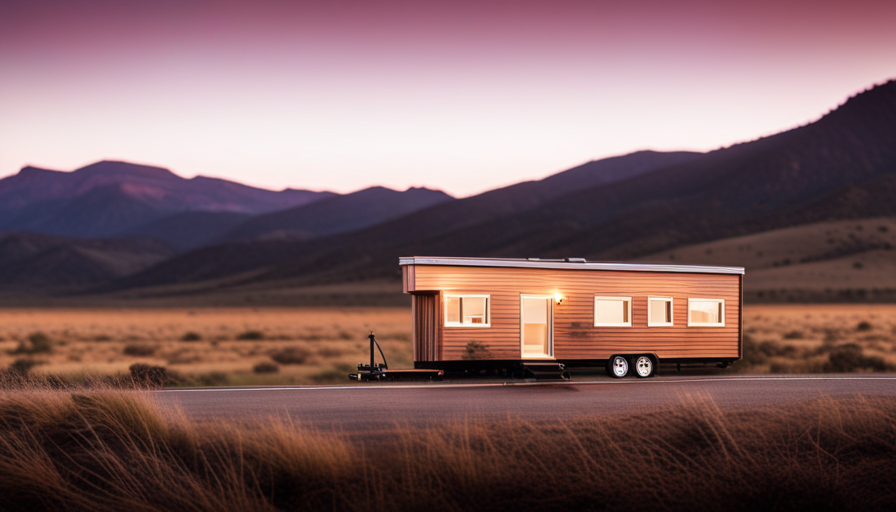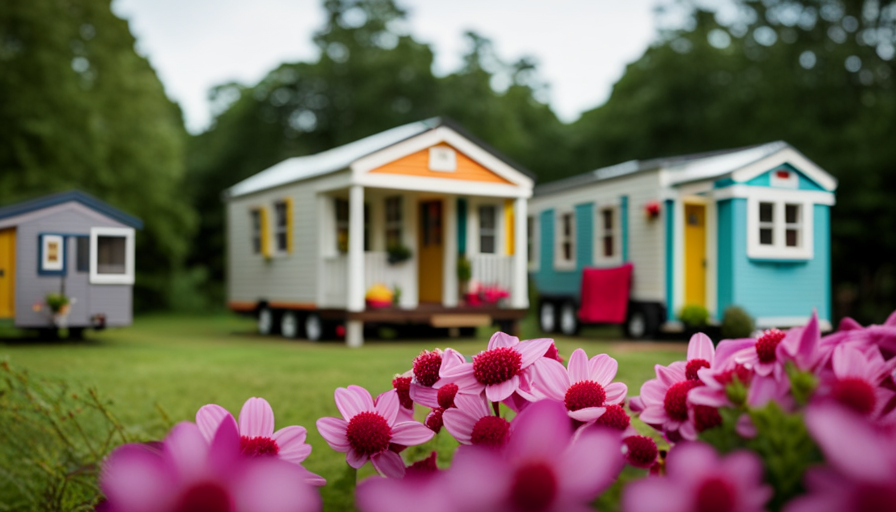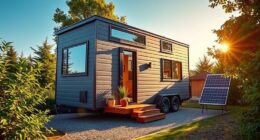Are you tired of constantly paying rent and feeling like your money is being wasted? Imagine having your own place that is both cozy and practical without breaking the bank. Welcome to the world of tiny homes, where size doesn’t matter and affordability is key.
These pint-sized dwellings are taking the real estate market by storm, offering a solution to the ever-increasing housing costs. But just how much is a tiny house? Prepare to be amazed, as the answer may surprise you.
In this article, I will delve into the factors that affect the cost of a tiny house, reveal the average price tag you can expect, and explore the hidden costs you need to consider. I will also provide tips on financing and budgeting for your tiny dream home, along with the pros and cons of living in a compact space.
Get ready to embark on a journey into the world of tiny houses and discover if this minimalist lifestyle is right for you.
Key Takeaways
- Tiny houses offer an affordable solution to high housing costs.
- The average cost of a tiny house ranges between $30,000 and $60,000, depending on various factors.
- Financing options for tiny houses may include personal loans and RV loans, as traditional mortgage lenders may not finance them.
- Ongoing expenses for living in a tiny house include utilities, maintenance, land rental, and insurance.
Factors Affecting the Cost of a Tiny House
So, you’re probably wondering, how much does a tiny house actually cost? Well, the cost of a tiny house can vary greatly depending on several factors.
One important factor to consider is the hidden costs associated with building or buying a tiny house. These hidden costs can include things like permits, land, utilities, and even furniture. It’s important to budget for these additional expenses to avoid any surprises down the road.
Another factor that affects the cost of a tiny house is the financing options available. Traditional mortgage lenders may not be willing to finance a tiny house, so you’ll have to explore alternative options such as personal loans or RV loans. These financing options may have different interest rates and repayment terms, so it’s important to carefully consider which one is the best fit for your financial situation.
Now, let’s transition into the subsequent section about the average cost of a tiny house. While there is no set price for a tiny house, the average cost tends to range between $30,000 and $60,000. Of course, this can vary depending on factors such as size, materials used, location, and additional features.
Average Cost of a Tiny House
When considering the average cost of a tiny house, it’s important to explore the various options available.
Basic DIY builds tend to be the most affordable, allowing individuals to customize their space while keeping costs down.
Pre-built and modular options offer a middle ground, providing convenience and efficiency at a slightly higher price point.
For those seeking luxury and high-end designs, there are options available that feature top-of-the-line materials and amenities, but they come with a higher price tag.
Basic DIY Builds
Building a tiny house on your own can be a cost-effective and rewarding way to create your dream home. With basic DIY builds, you have complete control over the design and customization of your tiny house. Here are four key cost considerations to keep in mind:
-
Size: The smaller the house, the less materials and labor required, resulting in lower costs.
-
Materials: Opt for affordable, sustainable materials like reclaimed wood or recycled materials to save money.
-
Design: Simple and straightforward designs are easier to build and require fewer materials and labor.
-
Skills and Time: Assess your own DIY abilities and time availability to determine if you can handle the project on your own or if you need to hire professionals.
By considering these factors, you can keep the costs of your basic DIY tiny house build to a minimum.
Moving on to pre-built and modular options, you can explore alternative methods of obtaining your tiny dream home.
Pre-built and Modular Options
If you’re looking for an easier option, you can explore pre-built and modular alternatives, like assembling a puzzle or putting together a Lego set. Pre-fabricated options offer a convenient and efficient way to have a tiny house without the hassle of DIY construction.
These pre-built homes are designed and built off-site, and then delivered to your desired location. They come in a range of sizes and styles, and often offer customizable options to suit your specific needs. While they may not have the same level of customization as a DIY build, pre-built and modular homes provide a great solution for those who want a simpler and quicker process. They can also be a cost-effective option, depending on the size and features you choose.
Transitioning into the subsequent section about luxury and high-end designs, there are also pre-built options available for those looking for a more luxurious tiny house experience.
Luxury and High-End Designs
One option for those seeking a more extravagant and sophisticated living experience is to explore luxury and high-end designs in the world of tiny homes. These custom-designed miniature dwellings offer a range of luxurious amenities and features that elevate the tiny house living experience to a whole new level.
Here are some of the key elements that make luxury tiny homes truly exceptional:
- Spa-like bathrooms with high-end fixtures and finishes
- State-of-the-art kitchens with top-of-the-line appliances
- Expansive windows that provide breathtaking views and ample natural light
- High-end materials and finishes throughout the interior
- Customized storage solutions that maximize space and organization
With luxury tiny homes, you can enjoy all the comforts and conveniences of a traditional home, but on a smaller scale. However, it’s important to consider the hidden costs associated with these upscale designs, which will be discussed in the next section.
Hidden Costs to Consider
Don’t underestimate the sneaky expenses that can catch you off guard when buying a tiny house. Hidden costs are one of the most common mistakes that people make when they decide to downsize and embrace the tiny house lifestyle. While the initial price tag of a tiny house may seem affordable, there are several additional expenses that you need to consider.
Firstly, you’ll want to factor in the cost of land. Owning or renting a piece of land to park your tiny house can add a significant amount to your budget. Additionally, you may need to invest in permits and utilities such as water, electricity, and sewage connections. These expenses can vary depending on your location and local regulations.
Maintenance and repairs are another hidden cost that many people overlook. Just like any other home, tiny houses require regular upkeep and occasional repairs. It’s important to budget for these expenses to ensure that your tiny house remains in good condition and retains its value.
Lastly, don’t forget about insurance. While tiny houses are generally less expensive to insure compared to traditional homes, it’s still an expense that you need to account for.
Considering these hidden costs is crucial when budgeting for a tiny house. By being aware of these potential expenses, you can better plan your financing and ensure that you have a realistic budget in place.
Financing and Budgeting for a Tiny House
When it comes to financing and budgeting for your dream of living in a tiny oasis, you’ll find that navigating the financial landscape is like embarking on a journey through a maze of numbers and possibilities. The good news is that there are various tiny house financing options available to help you turn your dream into a reality.
One popular financing option is securing a personal loan. These loans typically have lower interest rates compared to credit cards and can provide you with the funds needed to build or purchase your tiny house. Another option is to explore RV loans, especially if your tiny house is on wheels. RV loans often have longer terms and lower interest rates, making them an attractive choice for financing a mobile tiny home.
Budgeting for a small living space requires careful consideration of your expenses. While the cost of a tiny house itself may be lower than a traditional home, there are other factors to consider. Utilities, maintenance, and land rental fees are ongoing expenses that should be factored into your budget.
In order to make budgeting easier, here is a table that breaks down some common expenses associated with tiny house living:
| Expense | Average Cost |
|---|---|
| Utilities | $100-$200/month |
| Maintenance | $500-$1000/year |
| Land Rental | $200-$500/month |
| Insurance | $500-$1000/year |
By carefully considering these expenses and exploring your financing options, you can create a realistic budget that will allow you to live comfortably in your tiny house. Now that we have discussed financing and budgeting, let’s explore the pros and cons of living in a tiny house.
Pros and Cons of Living in a Tiny House
Living in a compact, cozy space offers a unique opportunity to simplify your lifestyle and embrace a more intentional way of living. There are several advantages to living in a tiny house.
Firstly, the cost of living is significantly lower compared to traditional homes. With a smaller square footage comes reduced utility bills and maintenance costs. Additionally, the smaller space encourages minimalism and forces you to declutter, allowing you to focus on what truly matters. Moreover, tiny houses are often mobile, giving you the freedom to travel and explore different locations without the hassle of packing and unpacking.
However, there are also disadvantages to consider. Limited space can be a challenge, especially if you have a growing family or enjoy hosting gatherings. Storage can become an issue, and you may need to be creative in finding solutions. Privacy can also be compromised, as there are often no separate rooms in a tiny house. Noise and lack of personal space can become sources of frustration.
Living in a tiny house has its advantages and disadvantages. It offers a chance to simplify and live more intentionally, while also presenting challenges in terms of limited space and privacy. Despite these drawbacks, many people find the benefits of tiny house living outweigh the disadvantages. Transitioning to the next section, let’s explore popular tiny house designs and styles.
Popular Tiny House Designs and Styles
If you’re looking to embrace a more intentional and compact lifestyle, you’ll be delighted to discover the variety of popular designs and styles available for your dream tiny home.
From sleek and modern to rustic and charming, there’s a tiny house design to suit every taste and preference. One popular style is the traditional cottage, featuring a cozy and nostalgic feel with its pitched roof and quaint exterior.
For those who prefer a more contemporary look, the minimalist design offers clean lines, large windows, and a sleek finish. Another trendy option is the industrial style, which incorporates elements like exposed brick, metal accents, and open floor plans.
When it comes to finding and buying a tiny house, there are a few key tips to keep in mind. First, research local builders and designers who specialize in tiny homes. They can provide valuable insight and expertise to help you create your ideal space.
Additionally, consider attending tiny house festivals or tours to see different designs in person and gather inspiration. Finally, don’t forget to factor in the cost of land or a parking spot for your tiny house.
As we transition into the subsequent section about eco-friendly features and sustainability, it’s important to note that many tiny house designs incorporate these principles.
Eco-Friendly Features and Sustainability
When it comes to eco-friendly features and sustainability in tiny houses, there are three key points to consider: energy efficiency and solar power, water conservation and rainwater harvesting, and sustainable materials and building practices.
These features not only help reduce the environmental impact of the tiny house, but also contribute to a more sustainable and self-sufficient lifestyle. By incorporating energy-efficient appliances, solar panels, low-flow fixtures, and rainwater collection systems, tiny house owners can minimize their carbon footprint and live more sustainably.
Furthermore, using sustainable materials such as reclaimed wood, bamboo, and recycled materials, along with employing green building practices like passive solar design and proper insulation, can further enhance the eco-friendliness of a tiny house.
Energy Efficiency and Solar Power
With energy efficiency and solar power, a tiny house can be as cost-effective as a sunflower turning towards the sun. By incorporating solar panel installation and energy-efficient appliances, tiny house owners can significantly reduce their reliance on traditional energy sources.
Solar panels can be installed on the roof of the tiny house, harnessing the power of the sun and converting it into electricity. This renewable energy source not only reduces electricity bills but also decreases the carbon footprint of the house.
Energy-efficient appliances, such as LED lights and low-flow fixtures, further contribute to the energy savings. By optimizing energy usage, tiny house owners can enjoy a comfortable living space while minimizing their impact on the environment.
Transitioning into the subsequent section about water conservation and rainwater harvesting, the focus shifts from energy to another essential resource for sustainable living.
Water Conservation and Rainwater Harvesting
By implementing water conservation techniques and utilizing rainwater harvesting systems, you can significantly reduce your reliance on traditional water sources and contribute to a more sustainable lifestyle.
Water conservation is crucial in a tiny house, as it allows you to minimize water waste and maximize efficiency. Simple practices like installing low-flow faucets and showerheads, as well as using dual-flush toilets, can make a big difference in reducing water consumption.
Additionally, rainwater harvesting systems can collect and store rainwater for various uses such as flushing toilets, watering plants, and even drinking with proper filtration. This not only saves water but also reduces the strain on municipal water supplies.
Transitioning into sustainable materials and building practices, it’s important to consider eco-friendly options that further minimize the environmental impact of your tiny house construction.
Sustainable Materials and Building Practices
When it comes to building a tiny house, water conservation and rainwater harvesting are essential practices to consider. However, they are just a part of the bigger picture of sustainability. In this section, I will discuss sustainable materials and building practices that can be used in the construction of a tiny house.
Sustainable tiny house designs prioritize the use of eco-conscious building methods and materials that minimize environmental impact. Here are four key aspects to consider:
-
Energy-efficient insulation: Using materials like recycled denim or cellulose insulation can help reduce heat loss and minimize energy consumption.
-
Renewable energy sources: Incorporating solar panels or wind turbines can provide clean and sustainable energy for powering the tiny house.
-
Recycled and reclaimed materials: Utilizing salvaged materials, such as reclaimed wood or recycled metal, reduces the demand for new resources and gives a unique character to the tiny house.
-
Water-efficient fixtures: Installing low-flow faucets, showers, and toilets can significantly reduce water consumption without sacrificing comfort.
By implementing these sustainable practices, a tiny house can be both environmentally friendly and cost-effective.
Now, let’s move on to the next section about tips for finding and buying a tiny house.
Tips for Finding and Buying a Tiny House
To find and buy a tiny house, start by researching different listings and attending open houses to get a feel for what’s available in your desired price range. When searching for affordable options, it’s important to consider factors such as the size, location, and condition of the tiny house. Look for listings that offer detailed descriptions and clear photographs, so you can accurately assess whether the house meets your needs.
Additionally, be prepared to navigate zoning regulations, as tiny houses may have specific requirements depending on the area. It’s crucial to familiarize yourself with local zoning laws and building codes to ensure that you can legally live in the tiny house you choose. Some areas have restrictions on the size, placement, and utilities of tiny houses, so it’s essential to do thorough research.
By being knowledgeable about the process and taking the time to explore different options, you can find a tiny house that fits your budget and lifestyle.
Moving on to the real-life stories and experiences of tiny house living, it’s fascinating to hear how individuals have adapted to a minimalist lifestyle and created unique homes in unconventional spaces.
Real-Life Stories and Experiences of Tiny House Living
In my experience, one of the most valuable resources for learning about tiny house living has been interviews with actual tiny house owners. These conversations have provided me with insights into the challenges and successes of living in a small space, as well as the lessons they’ve learned along the way.
From these interviews, I’ve gained valuable advice for beginners considering the tiny house lifestyle, which has helped me navigate the unique aspects of this alternative living arrangement.
Interviews with Tiny House Owners
Imagine yourself sitting down in a cozy living room, listening to tiny house owners talk about their experiences. During my interviews with these homeowners, I gathered valuable insights into the challenges and rewards of living in a tiny house.
One common theme that emerged was the importance of careful planning and consideration before downsizing. Many owners advised conducting thorough research and seeking advice from others in the tiny house community. They also emphasized the need to be realistic about the limitations and sacrifices that come with living in a small space.
However, despite the initial challenges, the owners shared stories of immense satisfaction and fulfillment. They spoke of the freedom gained from simplified living and the joy of being able to focus on what truly matters.
Transitioning into the subsequent section about challenges and successes, these interviews shed light on the journey of tiny house living.
Challenges and Successes
One interesting statistic to emphasize the challenges and successes of living in a small space is that 78% of tiny house owners reported a decrease in their monthly expenses. This is a significant benefit that often comes with downsizing and living in a tiny house.
However, it is important to acknowledge that there are challenges associated with living in such a small space. One of the main challenges is the impact it can have on mental health. The limited space can sometimes make people feel claustrophobic and restricted. It is essential to find ways to create a sense of openness and to develop coping mechanisms to deal with the challenges.
Despite these challenges, many tiny house owners have reported great successes in terms of living a more minimalist and sustainable lifestyle. They have found joy in simplifying their lives and reducing their environmental footprint.
Transitioning into the subsequent section about ‘lessons learned and advice for beginners’, it is crucial to consider these challenges and successes as valuable lessons for those just starting their tiny house journey.
Lessons Learned and Advice for Beginners
After facing numerous challenges and experiencing some successes in the process, I’ve gained valuable lessons and insights that I want to share with beginners in the world of tiny houses.
One of the most important lessons I learned is the significance of careful planning and research before diving into building a tiny house. It’s crucial to have a clear vision of what you want and to consider all the practical aspects, such as zoning regulations and budget constraints.
Additionally, it’s essential to be flexible and adaptable throughout the construction process, as unexpected hurdles are bound to arise. My advice to beginners would be to start small and gradually expand your knowledge and skills.
Remember, building a tiny house is a journey that requires patience, perseverance, and continuous learning.
With these lessons learned and beginner tips in mind, let’s now explore the future of tiny houses.
The Future of Tiny Houses
As we look ahead, the future of tiny houses holds exciting possibilities for innovative and sustainable living. With future trends and technological advancements, tiny houses are set to become even more efficient and customizable to meet the needs of individuals and families.
One of the future trends in tiny houses is the integration of smart home technology. Imagine a tiny house that is equipped with voice-activated controls for temperature, lighting, and security, making it easy to control and monitor your living space. Additionally, advancements in renewable energy sources will make it possible for tiny houses to be completely off-grid, using solar panels and wind turbines to generate power.
Another trend that we can expect in the future is the use of modular construction techniques. This means that tiny houses can be easily expanded or modified as the needs of the occupants change. Modular components can be easily added or removed, allowing for a more flexible living space.
To give you a visual representation of the future of tiny houses, here’s a table that showcases potential advancements:
| Future Trends | Technological Advancements |
|---|---|
| Smart Home | Voice-activated controls |
| Off-grid living | Renewable energy sources |
| Modular design | Flexible living space |
The future of tiny houses is promising and exciting. With technological advancements and innovative design, tiny houses will continue to provide sustainable and customizable living options for individuals and families.
Frequently Asked Questions
What are some common challenges of living in a tiny house?
Living in a tiny house presents unique challenges of small living. Maximizing space is crucial in these homes, requiring creative storage solutions and efficient organization. However, the benefits of simplicity and minimalism can outweigh the challenges.
Are there any specific regulations or zoning laws that apply to tiny houses?
Tiny house regulations and legal requirements vary depending on location. Zoning laws, building codes, and permits are crucial considerations. It’s important to research and comply with these regulations to ensure that your tiny house is legal and safe.
How long does it typically take to build a tiny house?
Typically, it takes around 3-4 months to build a tiny house. The construction process involves careful planning, sourcing materials, and skilled labor. It’s like putting together a puzzle, with each step contributing to the final masterpiece.
Can you customize the layout and design of a tiny house?
Yes, you can customize the layout and design of a tiny house. There are various customization options available, allowing you to create a personalized living space. The interior design possibilities are endless, limited only by your imagination and budget.
Are there any maintenance costs associated with owning a tiny house?
Owning a tiny house comes with some maintenance costs. Regular upkeep like cleaning, repairs, and utilities are necessary. Additionally, insurance coverage is important to protect your investment. It’s crucial to budget for these expenses.
Conclusion
In conclusion, the cost of a tiny house can vary greatly depending on various factors such as size, location, materials, and additional features. On average, a tiny house can cost anywhere from $20,000 to $150,000.
However, it’s important to consider hidden costs such as land, utilities, and maintenance. Despite the potential financial challenges, many people are drawn to the idea of living in a tiny house due to its eco-friendly features and sustainability.
Interestingly, according to a survey, 68% of tiny house owners don’t have a mortgage, making it an affordable housing option for many.
As the tiny house movement continues to gain popularity, it’ll be interesting to see how it shapes the future of housing and community living.
Hi, I’m Emma. I’m the Editor in Chief of Tiny House 43, a blog all about tiny houses. While tree houses are often associated with childhood, they can be the perfect adult retreat. They offer a cozy space to relax and unwind, surrounded by nature. And since they’re typically built on stilts or raised platforms, they offer stunning views that traditional homes simply can’t match. If you’re looking for a unique and romantic getaway, a tree house tiny house might just be the perfect option.
